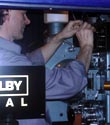|
|
This topic comprises 2 pages: 1 2
|
|
Author
|
Topic: Keystoning
|
|
|
John Pytlak
Film God

Posts: 9987
From: Rochester, NY 14650-1922
Registered: Jan 2000
|
 posted 01-16-2002 11:04 AM
posted 01-16-2002 11:04 AM





Although custom optics can be designed to correct for theatre design flaws that cause keystoning, "off-the-shelf" optics of common design are much less expensive.At last week's ITEA Seminar Series in Los Angeles, Dwight Lindsay of Schneider Optics announced a new version (3.0) of their very useful free "Theatre Design Pro" software, that helps in choosing lenses and designing auditoriums:
http://www.schneideroptics.com/software/theatre_design_pro/ ------------------
John P. Pytlak, Senior Technical Specialist
Worldwide Technical Services, Entertainment Imaging
Research Labs, Building 69, Room 7525A
Rochester, New York, 14650-1922 USA
Tel: 716-477-5325 Cell: 716-781-4036 Fax: 716-722-7243
E-Mail: john.pytlak@kodak.com
Web site: http://www.kodak.com/go/motion
| IP: Logged
|
|
Pat Moore
Master Film Handler

Posts: 363
Registered: Mar 2000
|
 posted 01-16-2002 11:26 AM
posted 01-16-2002 11:26 AM




David; this is as complicated a topic as the "focus" thread elsewhere in the forums.Part of the charm of theatres is that each one is different -- in screen size, viewing and projection angels, throw and so on. To custom design and make optical systems for a particular cinema design is incredibly complicated as well as expensive. Even Multiplex operators that build "identical" auditoriums within cinemas find: 1) they are seldom really identical, and 2) the design needs to change anyway, whether the original design is used once or a few times. Don't leave with the idea that today's projection optics are assembled from glass pieces out of a bunch of parts bins. These are very complicated optical designs, some of which take months and years to optimize and produce. Both ISCO and Schneider make products for a lot of industry segments, including cameras, medical imaging and other high technology lens requirements -- cinema projection lenses are among the most complicated designs they make. What we can do is design cinemas within bounds that use incredibly good optics like the Isco Ultra Star Plus and Schneider within their design and performance limits. We can accommodate a certain amount of downangle projection now and minimize to tolerable levels, if not eliminate, keystoning effects now. Stadium seating designs have brought a whole new bunch of challenges to film and image projection. Pat
| IP: Logged
|
|
|
|
|
|
|
|
|
|
|
|
Steve Guttag
We forgot the crackers Gromit!!!

Posts: 12814
From: Annapolis, MD
Registered: Dec 1999
|
 posted 01-17-2002 08:46 AM
posted 01-17-2002 08:46 AM




PC-Adapters are great but all of them are for 101.6mm (4") lens mounts so your projector must be able to handle that. Projectors with lens turrets often have the PC adapter's beneifits (if to a lesser degree) built in in the form of adjustable horizontal and rotational stops.When one uses a PC adatper, they are trading keystone effects for linearity affects (probably the lesser of the two when most people judge a picture). When on shifts a lens, you have limits on both the entering pupil of the lens and the exiting portion of your lens system (including the PC adapter or turret). This is more of an issue with shorter focal length lenses (as are used in the bulk of "modern" theatres. That said, Schneider just redesigned their PC adapter so the technology is being supported and is progressing. ISCO uses two eccentric cylinders that can allow about 5mm of shift at any point. Schneider has a slider for the lens tube so one can slide the lens about +/- 5mm (and maybe more). After that, with the Schneider adapter one can rotate the whole adapter to place the lens in the desired location. If one is merely trying to compensate for vertical keystone, then lock the adapter down with the slider in the vertical orientation and adjust until you picture is centered. For those that have not used PC adapters, you haven't lived until you try to use one with a Scope lens! It WILL try your patience. Steve Steve ------------------
"Old projectionists never die, they just changeover!"
| IP: Logged
|
|
|
|
Philippe Laude
Film Handler

Posts: 79
From: Longueville, Belgium
Registered: Jul 99
|
 posted 01-18-2002 03:03 PM
posted 01-18-2002 03:03 PM




Steve, you're right when you say:<For those that have not used PC adapters, you haven't lived until you try to use one with a Scope lens! It WILL try your patience.> I use an Isco PC adapter with an Isco Blue star anamorphic on a Bauer B11. The major problem is that almost each time I place the lens with its bracket (the B11 hasn't got a turret)it rotates somehow, although I handle it very, very carefully, so the image is a litlle crooked on the screen and I have to correct it.
I'm not sur I could express it clearly, my english being too poor. Philippe
------------------
| IP: Logged
|
|
Steve Guttag
We forgot the crackers Gromit!!!

Posts: 12814
From: Annapolis, MD
Registered: Dec 1999
|
 posted 01-18-2002 06:11 PM
posted 01-18-2002 06:11 PM




Your English is just fine...How is the lens rotating? Is the ISCO adapter slipping? Or is your indexing ring slipping? I have a modification for the PC-Cine adapter that will stop it from slipping (and not render it useless) but it does require disassembly and some milling. ISCO could have gotten the lock mechanism a bit better on it. Why they haven't corrected the locking design is a mystery to me except they are bound to be low production as compared to other items. When we design a multi-format booth (beyond the Flat/Scope lenses) then we use PC-Cine adapters quite a bit so all formats are centered on the screen. A recent installation had 11 lenses (5 on one projector and 6 on the other) and PC-Cine adapters are must to get all of those to center up. (the formats supported are 1.37, 1.66, 1.85, 2.39-Scope, Silent and 16mm on one projector). Steve ------------------
"Old projectionists never die, they just changeover!"
| IP: Logged
|
|
|
|
|
|
|
|
|
|
All times are Central (GMT -6:00)
|
This topic comprises 2 pages: 1 2
|
Powered by Infopop Corporation
UBB.classicTM
6.3.1.2
The Film-Tech Forums are designed for various members related to the cinema industry to express their opinions, viewpoints and testimonials on various products, services and events based upon speculation, personal knowledge and factual information through use, therefore all views represented here allow no liability upon the publishers of this web site and the owners of said views assume no liability for any ill will resulting from these postings. The posts made here are for educational as well as entertainment purposes and as such anyone viewing this portion of the website must accept these views as statements of the author of that opinion
and agrees to release the authors from any and all liability.
|

 Home
Home
 Products
Products
 Store
Store
 Forum
Forum
 Warehouse
Warehouse
 Contact Us
Contact Us




 Printer-friendly view of this topic
Printer-friendly view of this topic


















